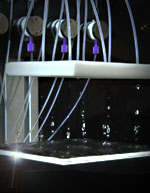Sisom Technology
SPEED is a refined chemical bath deposition process that allows the substrate to be coated with nanoparticles at high growth rates, and substantial film thickness. SPEED technology offers several improvements over currently available deposition technologies:
- Direct self-assembled nanomaterial film deposition;
- High-quality film growth on any hydrophilic substrate;
- Suitable for large surface area substrates;
- Higher deposition rates;
- Self-purifying process allows use of lower purity raw materials;
- Uses environmentally friendly water soluble materials; and
- Very flexible chemistry formulation for binary or more complex compound materials growth.
There are three SPEED deposition methodologies:
- Liquid-Phase SPEED (LPSPEED), where the heated substrate has a controlled liquid precursor covering it with a controlled replenishment and recirculation process;
- Vapor-Phase SPEED (VPSPEED), where precursor droplets on the order of 1 to 15 micrometers are generated and impinge on the heated substrate surface; and
- Gel Phase SPEED (GPSPEED), where the precursor impregnated in a gel is cast on a heated substrate.
Sisom Applications Lab
Sisom’s Apps Lab is capable of demonstrating coatings produced by all variations of the SPEED process: Liquid Phase, Vapor Phase and Gel Phase. These multiple processes provide great flexibility for the customer in terms of coating thickness, deposition rate, film quality, and substrate compatibility. We are ready to work with you to demonstrate our processes tailored to your substrate and coating requirements. A wide range of optical, morphological, structural and mechanical characterization techniques are available through our in-house capabilities and our relationship with the Advanced Materials Processing and Analysis Center (AMPAC) at UCF, Orlando, and the University of Florida – Gainesville.
The LPSPEED process grows film at a rate ranging from 10 to 100 nanometers per minute. The VPSPEED process offers higher growth rates, reaching more than 100 nanometers per minute. The GPSPEED process grows film at a rate much higher than 1,000 nanometers per minute. Figure 1(a) shows the automated VPSPEED system and the semi-automated LPSPEED system.
Growth Medium: Deionized water is the preferred growth medium. The aqueous solution consists of water-soluble compounds with complexing agents mixed to discourage unwanted homogeneous reactions and to ensure that film growth takes place only by heterogeneous reaction on the substrate.
Substrate: The substrate in all cases is maintained at a temperature ranging from 125°C to 300°C. The substrate needs to be hydrophilic, to enable the controlled hydroxyl ions (OH–) in the growth bath (LPSPEED), droplet (VPSPEED) or gel (GPSPEED) to adhere to the substrate.
Film Growth: The OH– attachment sites on the substrate are the nucleation sites, with more than 10E+12 of these sites per square centimeter. The heterogeneous reactions that eventually will lead to the formation of the desired molecules occur only if the substrate temperature supplies at least the activation energies of the reactions. The lateral growth of grains on the substrate is short lived, because there are millions of these occurring simultaneously until the surface area is consumed.
Film Quality: The film consists of densely packed grains with lateral sizes in the nano range of 50 to 100 nanometers, as shown in Figure 1(b). SPEED directly deposits nanoparticle-based films on metallic, glass and plastic substrates. Recrystallization of the film readily takes place with post growth temperature annealing, as shown in Figure 1(c).
SPEED, therefore, offers a very economical path to industrial deposition of nano-particle films without any organic binders. The process has the potential to fabricate new types of solar cells and LEDs, with new properties, and new capabilities.


